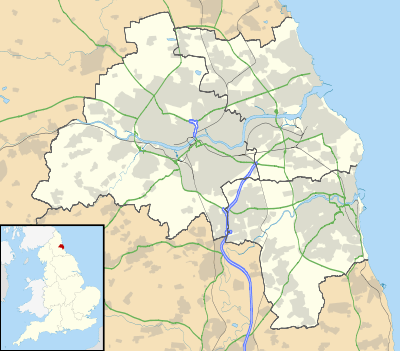Town Moor, Newcastle upon Tyne
The Town Moor is a large area of common land in Newcastle upon Tyne. It covers an area of around 1000 acres or 400ha,[1] and is larger than Hyde Park and Hampstead Heath combined, and also larger than New York City's Central Park (843 acres). Like them it is not on the edge of the city, but has suburbs all around it. It stretches from the city centre and Spital Tongues in the south out to Cowgate/Kenton Bar to the west, and from Gosforth to the north and Jesmond to the east.
| Town Moor, Newcastle upon Tyne | |
|---|---|
 | |
 Town Moor | |
| Type | Public park |
| Location | Newcastle upon Tyne |
| Nearest city | Newcastle upon Tyne |
| OS grid | NZ235664 |
| Coordinates | 54.992°N 1.633°W |
| Area | 1,000 acres (404.7 ha) |
| Created | 12th century |
| Open | 24 hours |
| Camp sites | No |
| Hiking trails | No |
At the south-eastern corner lies the Exhibition Park, but the rest of the Town Moor is not laid out as a park and is mostly treeless. Freemen of the city have the right to graze cattle on the moors, the rental income is distributed through the Town Moor Money Charity.[2]
The ornithologist and landscape architect John Hancock, after whom the nearby Hancock Museum is named, produced a planned layout for the Town Moor in 1868, which was only partly realised.
In 1873 a political demonstration in favour of full male suffrage took place on the moor which attracted 200,000 people, the largest recorded mass gathering to have taken place there.[3]
The Hoppings, said to be Europe's largest travelling fun fair, is held on the Town Moor during the last week in June.
The area of common land is actually split up into several sections, of which the Town Moor is but the major part. The area is intersected by the A189 road and the section on the other side of the road is known as Nuns Moor, and includes the Newcastle United Golf Club. Also part of Town Moor are Dukes Moor and Little Moor, both at its northern end, Hunters Moor to the west, and Castle Leazes Moor to the south.
The moor has recently had a pathway re-laid with more street lighting and CCTV.
The Town Moor is mentioned in the Maxïmo Park song "The Undercurrents".[4]
Sports and horse racing
Since the 18th century the Town Moor has hosted a significant number of sports and recreational events including rabbit coursing, horse racing and running. In 1892 the Town Moor hosted a baseball event where Wallsend became the national champions.
The Town Moor first hosted horse racing events in 1721 and competed with races held at Killingworth Moor. The Town Moor's course was approximately two miles long, a triangular shape and located at the northern area of the moor, just south of Gosforth. Part of the course ran through a cutting which can still be seen in the grass at the north of the moor. In 1800 a permanent stone grandstand was built at the north end of the racecourse; a fire damaged it for a short time in 1844. The road in front of this grandstand is still called Grandstand Road to this day. From 1833 the Northumberland Plate horse race was hosted at the Town Moor. The Town Moor attracted the larger events than Killingworth, but by the summer of 1881 the Town Moor hosted its last race and racing moved to Gosforth Park that same year.[5][6]
A Smallpox Isolation Hospital was built on the western side of Town Moor in 1882, and demolished by 1958. The site is still visible as a fenced linear copse or wooded area near the bottom of Cow Hill, the larger of the two hills on the west perimeter of the moor.
Aerodrome
Town Moor Aerodrome opened in June 1916.[9][10] On 8 April 1921 a hangar at the aerodrome was destroyed by arson by an Irish Republican Army team led by Edward Kerrigan, after they overpowered the airfield's night-watchman.[11][12] Two aircraft were also destroyed.[11]
See also
References
- Newcastle City Council, Town Moor History and General Information Archived March 8, 2016, at the Wayback Machine Retrieved 2016-09-29
- The Freemen of Newcastle Archived May 13, 2015, at the Wayback Machine Retrieved 2009-10-25
- "Archived copy". Archived from the original on 2014-09-03. Retrieved 2014-08-30.CS1 maint: archived copy as title (link)
- Maxïmo Park The Undercurrents lyrics Archived March 12, 2016, at the Wayback Machine Retrieved 2014-02-22
- "Tyne and Wear HER(4022): Newcastle, Town Moor, Race Course - Details". TW Site Lines. Retrieved 6 May 2017.
- "Sporting life of Tyne and Wear revealed: Part two". The Evening Chronicle. 9 September 2010. Retrieved 6 May 2017.
- "What is the Mela?". Archived from the original on 2018-03-31. Retrieved 2018-03-30.
- "Newcastle parkrun | Newcastle parkrun". Parkrun.org.uk. 2012-10-04. Retrieved 2019-04-27.
- "Newcastle (Town Moor) Aerodrome". North East Land Sea Air Museum. Retrieved 27 April 2019.
- "Newcastle, town moor, aerodrome | sitelines.newcastle.gov.uk". Tyne and Wear Sitelines. Newcastle City Council. Retrieved 27 April 2019.
- "Episode 3 — Series 2". A House Through Time. Series 2. Episode 3. 22 April 2019. BBC Television.
- "Jarrow in the 1920s - the Irish Troubles". Donmouth. Retrieved 28 April 2019.